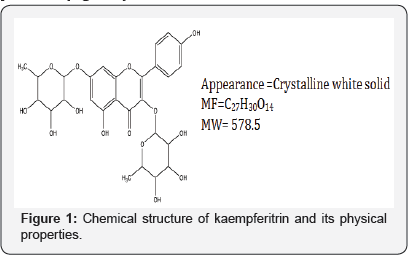Therapeutic Potential of Kaempferitrin in Diabetes Mellitus-Juniper Publishers
JUNIPER PUBLISHERS-OPEN ACCESS JOURNAL OF DRUG DESIGNING & DEVELOPMENT
Abstract
Diabetes mellitus is one of the leading causes of death in the world being one of the main targets of research. Plants have historically been an important source for molecules with therapeutic potential in different diseases. Kaempfertrin is a flavonoid that can be extracted from a wide variety of plants. Kaempferitrin has shown a therapeutic activity on diabetes mellitus in vitro and on in vivo models. This aim of this short review was to collect the actual research reports of the therapeutic potential of kaempferitrin on diabetes mellitus.
Keywords: Diabetes mellitus; Kaempferitrin; Hyperglycemia; Plants
Introduction
Diabetes mellitus (DM) is a group of physiological dysfunctions characterized by hyperglycemia resulting directly from insulin resistance, inadequate insulin secretion, or excessive glucagon secretion. There are two types of diabetes; type 1 is an autoimmune disorder leading to the destruction of pancreatic beta cells. Type 2 diabetes, which is more common, is primarily a problem of progressively impaired glucose regulation due to a combination of dysfunctional pancreatic beta cells and insulin resistance [1]. DM is a disease that could directly affect the life quality of patients. Chronic hyperglycemia of diabetes is associated with long-tem damage, dysfunction, and failure of different organs, especially the eyes, kidneys, nerves, heart, and blood vessels [2]. Nowadays, the research on the discovery of a molecule capable to regulate glycaemia is pointing to natural products. Kaempferitrin (KM) is a plant metabolite belonging to a group of compounds known as flavonoids. Structurally, KM is formed by kaempferol molecule bounded to two sugars molecules. KM has been widely studied for its effect on diabetes; the aim of this short review is to gather information of KM on diabetes research.
In vitro and animal evidence
In a recent study, the effect showed by KM on the glycolytic enzyme 6-phosphofructo-1-kinase (PFK) in skeletal muscle, liver and adipose tissue of mice was evaluated. These experiments showed that KM enhances the lytic action of PFK in liver tissue, suggesting that the molecule is capable to promote glucose utilization by the tissue. In the same report, it was observed that KM in a concentration of 4mg/kg reduced the blood glucose to 61% in diabetic mice after 120 minutes, concluding that the KM is a molecule capable of reducing hyperglycemia on mice via stimulation of PFK, this capacity is closely related to the sugars linked in the chemical structure of KM [3].
In alloxan induced diabetic rats model, KM showed hypoglycemic effect at doses of 50, 100 and 200mg/kg one hour after treatment. In addition, to non-diabetic rats did not reduce blood glucose levels. Besides in this study also was evaluated the antioxidant properties of KM, obtaining high reactivity with the compound used to assess this capacity 1,1-diphenil-2-picryl hydrazil model (DPPH) with an IC50 of 84.0±7.8mm. Those, KM exhibited inhibition of myeloperoxidase and decrease in lipid per oxidation [4].
Insulomimetic effect
Insulin is a hormone that plays an important role regulating the blood sugar levels. Kaempferitrin has shown stimulatory effect on glucose uptake in muscle tissue as well as the ability to lower blood glucose levels in diabetic rats, indicating that kaempferitrin has an insulin-like action [5]. This property of kaempferitrin could be useful on patient with insulin production problems (Figure 1).

The obesity is linked to diabetes. One of the reasons of this relation between obesity and diabetes is the low secretion of adiponectin in obesity. The plasma levels of adiponectin are inversely correlated with the degree of insulin resistance. Kaempferitrin was able to activate the insulin pathway and stimulate secretion of adiponectin in 3T3-L1 cells, up-regulating level of Phosphorylation on insulin receptor beta and insulin receptor substrate 1, and ser473 site in Protein kinase B (PKB/akt). Kaempferitrin was capable to translocate GLUT4 to membrane and increases level of GLUT4 protein. Kaempferitrin also stimulated more sustained adiponectin secretion than insulin did. This study provided evidence of the dual effects of kaempferitrin. It improved insulin resistance by the activation of the classical insulin transduction pathway, and increased adiponectin secretion [6].
Conclusion
Kaempferitrin is a natural molecule with interesting therapeutic activity on diabetes mellitus, however further research is necessary on toxicity to consider this molecule as a good candidate to treat diabetes mellitus.
For more Open Access Journals in Juniper Publishers please click on: https://juniperpublishers.com
For more articles in Open Access Novel Approaches in Drug Designing & Development please click on: https://juniperpublishers.com/napdd/index.php
For more Open Access Journals please click on: https://juniperpublishers.com
To know more about Juniper Publishers please click on: https://juniperpublishers.business.site/



Comments
Post a Comment